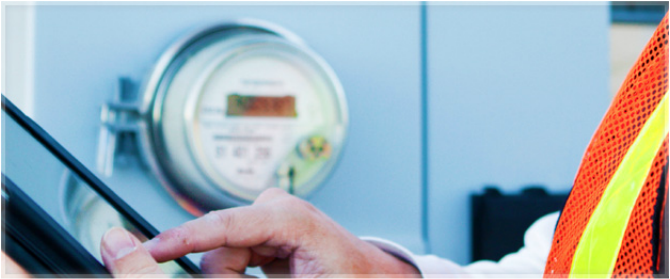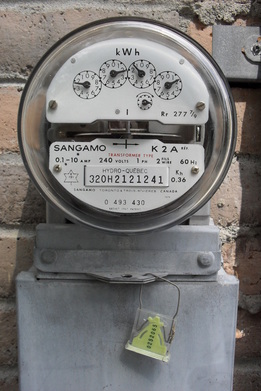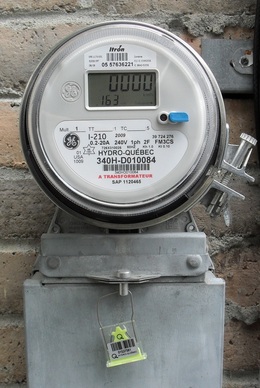|
A smart meter is usually an electronic device that records consumption of electricity or natural gas in intervals of an hour or less and communicates that information at least daily back to the utility for monitoring and billing purposes. Smart meters enable two-way communication between the meter and the central system. Unlike home energy monitors, smart meters can gather data for remote reporting. Such an advanced metering infrastructure (AMI) differs from traditional automatic meter reading (AMR) in that it enables two-way communications with the meter.
Smart meters, also called advanced digital meters, are the equivalent of a home’s electricity nerve center, connecting it to the Smart Grid and enabling consumers to have better control over their usage and spending. Traditional Meters vs. Smart Meters
Utilities across the country are in the process of a phased deployment that will eventually equip millions of homes nationwide with smart meters. Hundreds of thousands of electricity customers throughout the country have already had Smart Meters installed in their homes.
As a matter of code, electric meters are supposed to be serviced at least once (or twice) per year for accuracy. This test takes no more than a few minutes, and allows the technician to determine whether or not a meter is providing an accurate reading to the customer. This is especially important come billing time, and a single miscalculation can result in a dramatically different bill than what the customer is used to.
Myths
Smart meters report their readings nightly using a radio transmitter installed on each device. Each transmitter communicates with adjoining meters to create a net grid of information that makes its way to the electric company. If a meter fails to register any usage, or reports a fault, the company can respond immediately and send a technician to investigate. When this happens, the customer generally doesn’t even notice that anything went wrong at all.
In addition, smart meters are digital by nature, requiring less moving parts, which makes them last longer and provide accurate results for greater periods of time between calibration.
There are some popular rumors spreading around about smart meters and what they’re capable of. In most cases, representatives in a call center can’t turn your power back on with the press of a button. There is still a physical lever that must be lifted, locked, and tagged by a technician for power to be restored.
Smart meters also have no control over your thermostat. This rumor was started because many electric companies provide free programmable thermostats to their customers that can, in the event of extreme power usage, turn off the customer’s AC for 15-20 minutes by radio signal. This isn’t a task the meter is capable of doing, and is in no way connected. Smart meters also aren’t immune to fault. They require calibration and testing regularly. In some cases, a meter reader will still come by to double-check the reading. Locking the gate and ordering your attack chihuahua to bite meter readers isn’t going to improve the quality of your service, or the accuracy of your bills. Having a human double-check the meter is a good thing, so expect regular visits from the electric company, just as before. Below is a great video that covers a few more myths.
Traditional meters are mechanical in nature, and because of this, they contain constantly moving parts that need to work in perfect sync in order to provide an accurate reading. Over time, these meters have a tendency to slow down, resulting in a lower reading than what’s actually used by the customer. In some cases, the meter can stop almost entirely, like a car that has engine trouble. Sure, it may kick in and register a few moments of usage here or there, but it could also crawl to a standstill. In these cases, the customer may or may not notice a change in their bill. Lower than expected bills should always be a cause for concern, especially if the change is significant enough to be unbelievable.
Unfortunately, most users will shrug off a small bill, and after a period of time the electric utility will notice the fault in the meter. Once the meter is calibrated, and a month of usage goes by, the utility then has the ability to calculate estimated loss based on the broken equipment. This estimate may take a few months of use prior to and one month (or more) after the breakdown to create a usage average that is then billed to the customer. The unusually high bill typically results in a call to the utility and a dispute to be filed.
0 Comments
Your comment will be posted after it is approved.
Leave a Reply. |
Mikhail Skachko"Customer is always right, even if they are wrong." Archives
February 2016
Categories |
Some of our Clients
"After taking a chance on a USEC Broker, we are happy to have consistent savings in the last 4 years over ComEd. With USEC knowledge and experience, they were able to provide us with multiple options and steer us in the right direction to cutting cost. Everything has been A+ so far."
- Chicagoland Restaurant -
- Chicagoland Restaurant -
|
U.S.E.C. LLC
d/b/a US Energy Consultants 13215 Stafford Rd, Suite #500 Missouri City, TX 77489 713-772-0446 office 888-764-3888 fax |



















